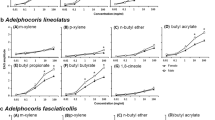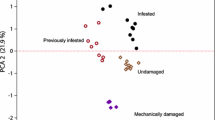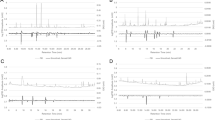Abstract
Behavioral and electrophysiological responses of winged Aphis fabae to volatiles of faba bean, Vicia faba (var. Sutton dwarf), plants were studied and semiochemicals used in host location were identified. In olfactometer bioassays, aphids spent significantly more time in the region of the olfactometer where V. faba volatiles from an intact plant were present than in control regions with clean air. This response also occurred when an air entrainment sample of a V. faba plant was used as the odor source. Coupled gas chromatography–electroantennography revealed the presence of 16 electrophysiologically active compounds in the air entrainment sample. Fifteen of these were identified as (Z)-3-hexen-1-ol, 1-hexanol, (E)-2-hexenal, benzaldehyde, 6-methyl-5-hepten-2-one, octanal, (Z)-3-hexen-1-yl acetate, (R)-(−)-linalool, methyl salicylate, decanal, undecanal, (E)-caryophyllene, (E)-β-farnesene, (S)-(−)-germacrene D, and (E,E,)-4,8,12-trimethyl-1,3,7,11-tridecatetraene. An olfactometer response was observed to a 15-component synthetic blend that comprised all identified compounds at the same concentration and ratio as in the natural sample, with the aphids spending significantly more time in the treated regions of the olfactometer where volatiles were present than in the control regions. These data are discussed in the context of insect host location and crop protection.



Similar content being viewed by others
References
Birkett, M. A., Bruce, T. J. A., Martin, J. L., Smart, L. E., Oakley, J., and Wadhams, L. J. 2004. Responses of female orange wheat blossom midge, Sitodiplosis mosellana, to wheat panicle volatiles. J. Chem. Ecol. 30:1319–1328.
Blackmer, J. L., Rodriguez-Saona, C., Byers, J. A., Shope, K. L., and Smith, J. P. 2004. Behavioral response of Lygus hesperus to conspecifics and headspace volatiles of alfalfa in a Y-tube olfactometer. J. Chem. Ecol. 30:1547–1564.
Blight, M. M., Pickett, J. A., Smith, M. C., and Wadhams, L. J. 1984. An aggregation pheromone of Sitona lineatus—identification and initial field studies. Naturwissenschaften 71:480–480.
Blight, M. M., Lemetayer, M., Delegue, M. H. P., Pickett, J. A., Marionpoll, F., and Wadhams, L. J. 1997. Identification of floral volatiles involved in recognition of oilseed rape flowers, Brassica napus by honeybees, Apis mellifera. J. Chem. Ecol. 23:1715–1727.
Bromley, A. K., Dunn, J. A., and Anderson, M. 1979. Ultrastructure of the antennal sensilla of aphids.1. coeloconic and placoid sensilla. Cell Tissue Res. 203:427–442.
Bromley, A. K., Dunn, J. A., and Anderson, M. 1980. Ultrastructure of the antennal sensilla of aphids.2. Trichoid, chordotonal and campaniform sensilla. Cell Tissue Res. 205:493–511.
Bruce, T. J. A., Martin, J. L., Pickett, J. A., Pye, B. J., Smart, L. E., and Wadhams, L. J. 2003. cis-Jasmone treatment induces resistance in wheat plants against the grain aphid, Sitobion avenae (Fabricius) (Homoptera: Aphididae). Pest Manag. Sci. 59:1031–1036.
Bruce, T. J. A., Birkett, M. A., Blande, J., Hooper, A. M., Martin, J. L., Khambay, B., Prosser, I., Smart, L. E., and Wadhams, L. J. 2005a. Response of economically important aphids to components of Hemizygia petiolata essential oil. Pest Manag. Sci. 61:1115–1121.
Bruce, T. J. A., Wadhams, L. J., and Woodcock, C. M. 2005b. Insect host location: a volatile situation. Trends Plant Sci. 10(6):269–274.
Buttery, R. G., Light, D. M., Nam, Y., Merrill, G. B., and Roitman, J. N. 2000. Volatile components of green walnut husks. J. Agric. Food Chem. 48:2858–2861.
Cammell, M. E. 1981. The black bean aphid, Aphis fabae. Biologist 28(5):247–258.
Colazza, S., Mcelfresh, J. S., and Millar, J. G. 2004. Identification of volatile synomones, induced by Nezara viridula feeding and oviposition on bean spp., that attract the egg parasitoid Trissolcus basalis. J. Chem. Ecol. 30:945–964.
Cook, S. M., Khan, Z. R., and Pickett, J. A. 2007. The use of push–pull strategies in integrated pest management. Annu. Rev. Entomol. 52:375–400.
David, C. T., and Hardie, J. 1988. The visual responses of free-flying summer and autumn forms of the black bean aphid, Aphis fabae, in an automated flight chamber. Physiol. Entomol. 13:277–284.
Dawson, G. W., Griffiths, D. C., Pickett, J. A., Smith, M. C., and Woodcock, C. M. 1984. Natural inhibition of the aphid alarm pheromone. Entomol. Exp. Appl. 36:197–199.
Dicke, M., Gols, R., Ludeking, D., and Posthumus, M. A. 1999. Jasmonic acid and herbivory differentially induce carnivore-attracting plant volatiles in lima bean plants. J. Chem. Ecol. 25:1907–1922.
Douglas, A. E. 1997. Provenance, experience and plant utilisation by the polyphagous aphid, Aphis fabae. Entomol. Exp. Appl. 83:161–170.
El-Amri, A. 1999. Identification of vectors and natural hosts of faba bean necrotic yellows virus in Morocco. Al Awamia 99:27–31.
Fernandez-Quintanilla, C., Fereres, A., Godfrey, L., and Norris, R. F. 2002. Development and reproduction of Myzus persicae and Aphis fabae (Hom., Aphididae) on selected weed species surrounding sugar beet fields. J. Appl. Entomol. 126:198–202.
Gish, M., and Inbar, M. 2006. Host location by apterous aphids after escape dropping from the plant. J. Insect Behav. 19:143–153.
Griffiths, D. W., Robertson, G. W., Shepherd, T., and Ramsay, G. 1999. Epicuticular waxes and volatiles from faba bean (Vicia faba) flowers. Phytochemistry 52:607–612.
Guerin, P. M., Stadler, E., and Buser, H. R. 1983. Identification of host plant attractants for the carrot fly, Psila rosae. J. Chem. Ecol. 9:843–861.
Hardie, J., Isaacs, R., Pickett, J. A., Wadhams, L. J., and Woodcock, C. M. 1994a. Methyl salicylate and (−)-(1R,5S)-myrtenal are plant-derived repellents for back bean aphid, Aphis fabae Scop (Homoptera, Aphididae). J. Chem. Ecol. 20:2847–2855.
Hardie, J., Visser, J. H., and Piron, P. G. M. 1994b. Perception of volatiles associated with sex and food by different adult forms of the black bean aphid, Aphis fabae. Physiol. Entomol. 19:278–284.
Hern, A., and Dorn, S. 2004. A female-specific attractant for the codling moth, Cydia pomonella, from apple fruit volatiles. Naturwissenschaften 91:77–80.
Isaacs, R., Hardie, J., Hick, A. J., Pye, B. J., Smart, L. E., Wadhams, L. J., and Woodcock, C. M. 1993. Behavioral responses of Aphis fabae to isothiocyanates in the laboratory and field. Pestic. Sci. 39:349–355.
Ishiwari, H., Suzuki, T., and Maeda, T. 2007. Essential compounds in herbivore-induced plant volatiles that attract the predatory mite Neoseiulus womersleyi. J. Chem. Ecol. 33:1670–1681.
Kang, S. K., Chung, G. Y., and Lee, D. H. 1987. A convenient synthesis of (E)-beta-farnesene. Bull. Kor. Chem. Soc. 8:351–353.
Kennedy, J. S., and Booth, C. O. 1950. Methods for mass rearing and investigating the host relations of Aphis fabae Scop. Ann. Appl. Biol. 37:451–470.
Knudsen, J. T., Tollsten, L., and Bergstrom, L. G. 1993. Floral scents—a checklist of volatile compounds isolated by headspace techniques. Phytochemistry 33:253–280.
Lees, A. D. 1966. The control of polymorphisms in aphids. Adv. Insect Physiol. 3:207–277.
Leopold, E. J. 1990. Selective hydroboration of a 1,3,7-triene: homogeraniol. Org. Synth. 64:164–171.
Miller, J. R., and Cowles, R. S. 1990. Stimulo-deterrent diversion—a concept and its possible application to onion maggot control. J. Chem. Ecol. 16:3197–3212.
Mithofer, A., Wanner, G., and Boland, W. 2005. Effects of feeding Spodoptera littoralis on lima bean leaves. II. Continuous mechanical wounding resembling insect feeding is sufficient to elicit herbivory-related volatile emission. Plant Physiol. 137:1160–1168.
Müller, C. B., Williams, I. S., and Hardie, J. 2001. The role of nutrition, crowding and interspecific interactions in the development of winged aphids. Ecol. Entomol. 26:330–340.
Nault, L. R., Edwards, L. J., and Styer, W. E. 1973. Aphid alarm pheromones: secretion and reception. Environ. Entomol. 2:101–105.
Neeraj, V., Danish, M., Doomar, S., and Naqvi, Q. A. 1999. Studies’ on bean yellow mosaic virus infecting broad bean (Vicia faba L.) in Aligarh, India. Ann. Plant Prot. Sci. 7:51–54.
Ninkovic, V., Ahmed, E., Glinwood, R., and Pettersson, J. 2003. Effects of two types of semiochemical on population development of the bird cherry oat aphid Rhopalosiphum padi in a barley crop. Agric. For. Entomol. 5:27–33.
NIST 2005. NIST mass spectral search for the NIST/EPA/NIH mass spectral library version 2.0. Office of the Standard Reference Data Base, National Institute of Standards and Technology, Gaithersburg, Maryland.
Nojima, S., Linn, C., Morris, B., Zhang, A. J., and Roelofs, W. 2003. Identification of host fruit volatiles from hawthorn (Crataegus spp.) attractive to hawthorn-origin Rhagoletis pomonella flies. J. Chem. Ecol. 29:321–336.
Nottingham, S. F., Hardie, J., Dawson, G. W., Hick, A. J., Pickett, J. A., Wadhams, L. J., and Woodcock, C. M. 1991. Behavioral and electrophysiological responses of aphids to host and nonhost plant volatiles. J. Chem. Ecol. 17:1231–1242.
Pare, P. W., and Tumlinson, J. H. 1997. De novo biosynthesis of volatiles induced by insect herbivory in cotton plants. Plant Physiol. 114:1161–1167.
Park, K. C., and Hardie, J. 2002. Functional specialisation and polyphenism in aphid olfactory sensilla. J. Insect Physiol. 48:527–535.
Parker, W. E., and Biddle, A. J. 1998. Assessing the damage caused by black bean aphid (Aphis fabae) on spring beans, pp. 1077–1082, in Brighton Crop Protection Conference: Pests & Diseases 1998. Brighton, UK.
Pettersson, J. 1970. An aphid sex attractant. Entomol. Scand. 1:63–73.
Pickett, J. A., Wadhams, L. J., Woodcock, C. M., and Hardie, J. 1992. The chemical ecology of aphids. Annu. Rev. Entomol. 37:67–90.
Powell, G., and Hardie, J. 2001. The chemical ecology of aphid host alternation: how do return migrants find the primary host plant? Appl. Entomol. Zool. 36:259–267.
Powell, G., Maniar, S. P., Pickett, J. A., and Hardie, J. 1999. Aphid responses to non-host epicuticular lipids. Entomol. Exp. Appl. 91:115–123.
Prosser, I., Altug, I. G., Phillips, A. L., Konig, W. A., Bouwmeester, H. J., and Beale, M. H. 2004. Enantiospecific (+)- and (−)-germacrene D synthases, cloned from goldenrod, reveal a functionally active variant of the universal isoprenoid-biosynthesis aspartate-rich motif. Arch. Biochem. Biophys. 432:136–144.
Pruter, C., and Zebitz, C. P. W. 1991. Effects of Aphis fabae and Uromyces viciae favae on the growth of a susceptible and an aphid resistant cultivar of Vicia faba. Ann. Appl. Biol. 119:215–226.
Shannag, H. K., and Ababneh, J. A. 2007. Influence of black bean aphid, Aphis fabae Scopoli. on growth rates of faba bean. World J. Agric. Sci. 3:344–349.
Tasin, M., Backman, A. C., Coracini, M., Casado, D., Ioriatti, C., and Witzgall, P. 2007. Synergism and redundancy in a plant volatile blend attracting grapevine moth females. Phytochemistry 68:203–209.
Visser, J. H. 1986. Host odor perception in phytophagous insects. Annu. Rev. Entomol. 31:121–144.
Visser, J. H., Piron, P. G. M., and Hardie, J. 1996. The aphids’ peripheral perception of plant volatiles. Entomol. Exp. Appl. 80:35–38.
Wadhams, L. J. 1982. Coupled gas-chromatography–single cell recording—a new technique for use in the analysis of insect pheromones. Z. Naturforsch. C 37:947–952.
Wadhams, L. J. 1990. The use of coupled gas chromatography: electrophysiological techniques in the identification of insect pheromones, pp. 289–298, in A. R. McCaffery, and I. D. Wilson (eds.). Chromatography and Isolation of Insect Hormones and PheromonesPlenum, New York.
Williams, L., Rodriguez-Saona, C., Pare, P. W., and Crafts-Brandner, S. J. 2005. The piercing-sucking herbivores Lygus hesperus and Nezara viridula induce volatile emissions in plants. Arch. Insect Biochem. 58:84–96.
Acknowledgments
Rothamsted receives grant-aided support from the Biotechnology and Biological Sciences Research Council (BBSRC) of the United Kingdom. This work was supported by the Department of the Environment, Food and Rural Affairs (DEFRA).
Author information
Authors and Affiliations
Corresponding author
Rights and permissions
About this article
Cite this article
Webster, B., Bruce, T., Dufour, S. et al. Identification of Volatile Compounds Used in Host Location by the Black Bean Aphid, Aphis fabae . J Chem Ecol 34, 1153–1161 (2008). https://doi.org/10.1007/s10886-008-9510-7
Received:
Accepted:
Published:
Issue Date:
DOI: https://doi.org/10.1007/s10886-008-9510-7




